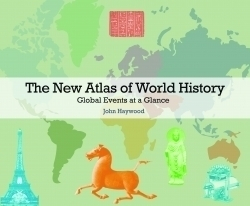The New Atlas of World History
Global Events at a Glance
No less than the history of the world—beginning 100,000 years ago and extending through 2010—is presented in The New Atlas of World History: Global Events at a Glance, using comprehensive maps, timelines, and pertinent graphics. Starting with a very approximate world population of 11 million in 6000 BC, the book charts the increase to 2010, when the world population grew to 6.91 billion.
John Haywood states that human history has been marked by “step-changes” in productivity that fueled social, cultural, and political changes and enabled mass movements of peoples, constantly reshaping the world. Following the last Ice Age, the first step-change largely began in the Middle East, as it boasted the greatest number of plants and animals suitable for domestication, which, in turn, allowed for a massive increase in the human population.
The second step-change occurred when farmers became capable of growing more food than they needed, creating the first form of wealth; those who controlled surplus food acquired power. Everyone no longer needed to be a farmer, so instead they devoted themselves to production, trade, military training, administration, or religion. These social and economic changes led to the growth of cities, states, and civilizations.
The Industrial Revolution brought about the third step-change, when manufacturing and services replaced agriculture as the primary source of wealth due to improvements in agricultural efficiency. Some farm labor left the land to work in urban factories.
This finely researched and artfully produced atlas is based on a sequence of more than fifty maps of the world at different times. They chart the evolution of migrations of early humans and include the spread of agriculture and the development of cultures, states, and empires. Timelines highlight the evolution of world religions, art, tools, wars, writing systems, and global trade. Haywood seamlessly combines history and geography to show not only population expansion but also cross-cultural contact and the growth of economic and social complexity.
Libraries, schools, and everyone interested in the past will want this book for their shelves. Resources include pages on further reading, sources of data and of illustrations, a reference map, and complete index.
John Haywood is an honorary research fellow in the Department of History at Lancaster University (UK). He has written four other books, including The Great Migrations: From the Earliest Humans to the Age of Globalization.
Reviewed by
Penny Hastings
Disclosure: This article is not an endorsement, but a review. The publisher of this book provided free copies of the book to have their book reviewed by a professional reviewer. No fee was paid by the publisher for this review. Foreword Reviews only recommends books that we love. Foreword Magazine, Inc. is disclosing this in accordance with the Federal Trade Commission’s 16 CFR, Part 255.

